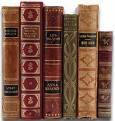                             |
|
ERNEST HEMINGWAY
(1899-1961) |
 |
BACKGROUND
- father = county treasurer (John, Sr.)
- mother = former school teacher (Olive)
- summers: manual laborer (on neighboring ranches)
- high school:
- school newspaper
- president of graduating class
- 1919-25: Stanford U….poor attendance, BUT no degree
- 1925-30:
- left college to be full-time writer in New York
- (no luck, back to California)
- drifted, read, wrote
- worked as manual laborer
- hod-carrier, fruit-picker, apprentice painter,
laboratory assistant, caretaker, surveyor
- 1st 3 books = basically ignored
- 1930: married (Carol Henning, 1st wife)
- #1: Carol Henning (divorced 1943)
- #2: Gwyn Conger (1943-48)
- #3: Elaine Scott (1950)
|
BACKGROUND
- Tortilla Flat (1935)
- marks a turn-around in his career
- Of Mice And Men (1937)
- The Grapes Of Wrath (1939)
- dispossessed Oklahoma family
- (Pulitzer Prize)
- World War II:
- war correspondent for the New York Herald Tribune
- North Africa & Italy
- post-WWII:
- prosperity
- materialism, acquisitiveness
- suburbia
- commercialization
- 1962: Nobel Prize for Literature
|
 |

 |
THEMES
- violence
- despair
- emotional unrest
- disillusionment
- world =
- harsh, cruel, violent, meaningless
- “devoid of traditional values and truths and instead
marked by disillusionment and moribund idealism”
- chaotic, confusing
- used darkness to symbolize humanity's lot in life
|
THEMES
- LOST GENERATION:
- American expatriates who were morally and spiritually
devastated by World War I
- 1920s
- Paris (literary capital of the 1920s)
- Gertrude Stein
- James Joyce, Ezra Pound
- Ford Madox Ford, and F. Scott Fitzgerald
|
 |

 |
STYLE
- short & simple syntax (economical prose style)
- simple diction
- journalistic, like a reporter
- concision, compression, selectivity, precision, &
immediacy
- repetition
- realism
- simple style, concreteness, honesty, objectivity
- (yet powerfulness)
- the terse, almost journalistic prose, the
compressed action, & the subdued yet suggestive
symbolism
- themes =
- violence, despair, & emotional unrest; disillusionment;
world = harsh, cruel, violent, meaningless, “devoid of
traditional values and truths and instead marked by
disillusionment and moribund idealism”; chaotic, confusing
|
STYLE
- short and simple sentence constructions,
- with heavy use of parallelism,
- --> which convey the effect of control, terseness,
and blunt honesty;
- purged diction
- which above all eschews the use of bookish,
Latinate, or abstract words
- --> thus achieves the effect of being heard or spoken or
transcribed from reality
- --> rather than appearing as a construct of the
imagination (in brief, verisimilitude)
- skillful use of repetition and a kind of
verbal counterpoint,
- which operate either by pairing or juxtaposing
opposites,
- or else by running the same word or phrase through
a series of shifting meanings and inflections.
- (Sheldon Norman Grebstein)
|
 |
LINKS
 LINKS
LINKS
|

























































